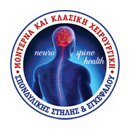
Dr. Georgios Dimogerontas, MD, MSc, PhD* explains what the osteoporotic fractures of the spine are and describes their new treatment methods.
What is the cause of the osteoporotic fractures of the spine?
The main causes of the osteoporotic fractures are the primary and secondary osteoporosis. The most common types of the primary osteoporosis are the postmenopausal osteoporosis, the age-related osteoporosis, and the idiopathic osteoporosis.
Which other factors may lead in an osteoporotic fracture?
Factors causing secondary osteoporosis are diabetes, Cushing disease and syndrome (hypercortisolism), hyperparathyroidism, chronic use of corticoids, sickle cell anemia, multiple myeloma, and prolonged immobilization for any reason.
How old are the patients that get osteoporosis?
In Greece, 19% of women and 11% of men over 60 years old get osteoporosis.
How common are osteoporotic fractures in the general population?
25% of women after menopause may get a vertebral compression fracture. The older the age, the higher the percentage. This can reach 40% in women over 80 years old.
Is a lot of force required for an osteoporotic fracture?
Unfortunately, osteoporotic fractures can take place with no special force, even automatically on several cases, that is without the patient suffering an injury. This is because of the fragility of the vertebral bodies that have the texture of a biscuit.
What are the signs of an osteoporotic fracture?
Intense pain in the spine or the lower back that does not respond satisfactorily to painkillers and anti-inflammatories is the most important symptom of an osteoporotic fracture at early stage. If it is left untreated, it can lead to body malformation (kyphosis or scoliosis) and neurological symptoms, such as weakness in walking, leg numbness, and urine and fecal incontinence or retention.
What is vertebroplasty and kyphoplasty?
Vertebroplasty and kyphoplasty are two similar, percutaneous, and minimally invasive surgeries (MIS) that are applied in the treatment of osteoporotic fractures. In both methods, a thin tube is placed in the body of the broken vertebra with the assistance of the portable X-ray machine (C-arm) or the surgical imaging system (O-arm). If the latter is used, acrylic cement is injected in order to strengthen the desalinated bone.
Before the cement injection in kyphoplasty, the doctor first tries to restore the broken vertebra with the assistance of a balloon that inflates within the bone.
What are the benefits of kyphoplasty?
Percutaneous kyphoplasty achieves two goals: pain is relieved with very small incisions in the spine or the lower back and kyphosis is treated, which leads to the restoration of the lost height due to the broken vertebral body.
However, the most important benefit of this method, especially to older patients, is the swift recovery with immediate mobilization and the ability to self-care.
When is the right time for kyphoplasty?
When the conservative treatment of the osteoporotic fractures is unsuccessful, the application of the aforementioned minimally invasive surgeries is required in order to relieve patients from pain and to prevent complications, such as severe kyphosis and the limited inflation of the thorax (that is the decrease of the breath depth), which can lead to pneumonia or pulmonary atelectasis, as well as complications due to chronic bed rest—especially to older patients, such as pressure ulcers, deep vein thrombosis, and lethal pulmonary embolism.
Who else could benefit from the advantages of kyphoplasty?
Tumor patients suffering from pathologic fractures either because of multiple myeloma or because of osteolytic metastases to the spinal bones and patients with painful traumatic fractures without spinal instability of spinal canal stenosis from detached splinters of bone.
How long does the patient need to remain hospitalized after kyphoplasty has been performed?
Patients mobilize immediately after the percutaneous kyphoplasty and are usually discharged in less than 24 hours.
Are there any advancements in kyphoplasty? What are the advantages of the new techniques?
One of the most recent advancements in kyphoplasty and vertebroplasty is the use of the O-arm (surgical imaging system) (Image 3) in combination with Neuronavigation (medical GPS) (image 4). The use of this technology—which is unfortunately only found in some clinics in Greece—gives us the ability to perform this kind of operation very precisely, eliminating the risk of any neurological complications.
To sum up, what are the advantages of the minimally invasive techniques of vertebroplasty and kyphoplasty?
The most important advantages of these techniques are:
- Very small incisions
- No loss of blood
- No postoperative pain
- Short period of hospitalization
And, of course, the swift recovery with no bed rest and its complications (pneumonia, pressure ulcers, vein thrombosis in the lower limbs, pulmonary embolism, etc.).
*Dr. Dimogerontas Georgios is a Neurosurgeon – Spine Surgeon, Director at the Neurosurgery Clinic of the METROPOLITAN HOSPITAL








